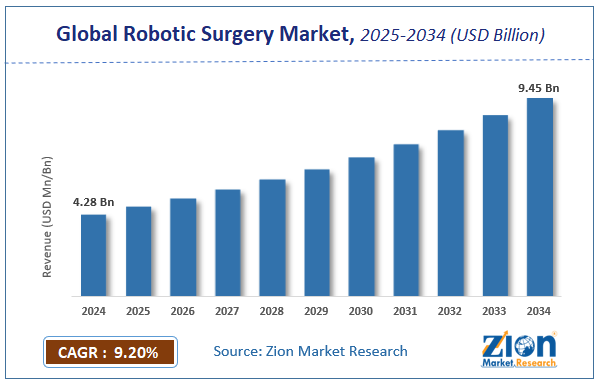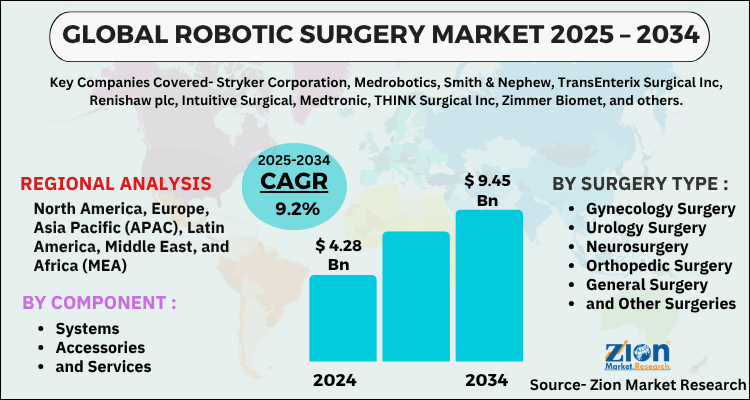Global Robotic Surgery Market Size, Share, Growth Analysis Report - Forecast 2034

Robotic Surgery Market By Component (Systems, Accessories, and Services), By Surgery Type (Gynecology Surgery, Urology Surgery, Neurosurgery, Orthopedic Surgery, General Surgery, and Other Surgeries), and By Region: Global and Regional Industry Overview, Market Intelligence, Comprehensive Analysis, Historical Data, and Forecasts 2025 - 2034
| Market Size in 2024 | Market Forecast in 2034 | CAGR (in %) | Base Year |
|---|---|---|---|
| USD 4.28 Billion | USD 9.45 Billion | 9.2% | 2024 |
Robotic Surgery Market Size
The global robotic surgery market size was worth around USD 4.28 Billion in 2024 and is predicted to grow to around USD 9.45 Billion by 2034 with a compound annual growth rate (CAGR) of roughly 9.2% between 2025 and 2034.
The report analyzes the global robotic surgery market's drivers, restraints/challenges, and the effect they have on the demands during the projection period. In addition, the report explores emerging opportunities in the robotic surgery industry.
Robotic Surgery Market: Overview
Robotic surgery, also known as robot-assisted surgery, enables medical professionals to carry out a variety of intricate treatments with greater accuracy, adaptability, and control than is feasible with traditional methods. Robotic surgery is frequently related to minimally invasive surgery, which involves operations done through small incisions. It may also be employed sometimes during various types of open surgery. A camera arm and motorized arms with surgical tools attached are part of the most popular clinical robotic surgical system. While sitting at a computer panel next to the operating table, the surgeon manages the arms. A high-definition, enlarged, 3D image of the surgical site is provided to the surgeon through the console. Other members of the team who assist with the procedure are under the surgeon's direction.
Key Insights
- As per the analysis shared by our research analyst, the global robotic surgery market is estimated to grow annually at a CAGR of around 9.2% over the forecast period (2025-2034).
- Regarding revenue, the global robotic surgery market size was valued at around USD 4.28 Billion in 2024 and is projected to reach USD 9.45 Billion by 2034.
- The robotic surgery market is projected to grow at a significant rate due to rising adoption of minimally invasive procedures, technological advancements, and increasing demand for precision surgery.
- Based on Component, the Systems segment is expected to lead the global market.
- On the basis of Surgery Type, the Gynecology Surgery segment is growing at a high rate and will continue to dominate the global market.
- Based on region, North America is predicted to dominate the global market during the forecast period.
Robotic Surgery Market: Growth Drivers
The benefits associated with robotic surgeries are likely to propel the market growth during the forecast period.
The advantages connected with robotic surgeries such as lesser incisions, fewer cuts, lower scarring, reduced discomfort, greater safety, quicker recovery times, and significant cost savings, are driving up demand for minimally invasive surgeries (MIS) globally. These benefits are enhanced by robotic minimally invasive surgery, which provides improved precision, repeatability, manageability, and effectiveness. The surgical success rate in the IRDG group was almost 98 percent; this was significantly higher than the CLDG (conventional laparoscopic distal gastrectomy) group, which taken into account for 89.5 percent success rate, as per a recent article on the contrast of surgical results among conventional laparoscopic and integrated robotic surgery for distal gastrectomy. All of these factors are likely to drive the global robotic surgery market.
Robotic Surgery Market: Restraints
Costly robotic surgical systems are the major restrain for the market growth.
Minimally invasive procedures cost less money than robotically assisted procedures. Only unique and complicated clinical situations are recommended for robotic hysterectomy by the American Congress of Obstetricians and Gynecologists. According to the organization, the cost of hysterectomy procedures in the US would increase by an estimated US$ 960 Mn if robotic surgery were to be used for all hysterectomies. The CyberKnife robotic system costs about US$ 4 million per unit, whereas the da Vinci system, one of the most popular robotic systems, prices between USD 1.5 million and US$ 2.5 million. The already high expense of robotic surgery is increased even further by the annual maintenance cost of a robot, which is close to USD 125,000. The typical cost of a robotic surgical operation ranges from US$ 2,500 to US$ 5,000.
Robotic Surgery Market: Opportunities
Increasing adoption of robotic surgery in ambulatory surgical centers is likely to offer better growth opportunities.
Ambulatory surgery centers (ASCs) are independent medical clinics with a focus on outpatient surgical, diagnostic, and preventative treatments. Governments, third-party payers, and patients all benefit greatly from the cost-effectiveness of ASCs. ASCs offer a lower-cost site of care compared to hospital outpatient departments, which according to a study by Healthcare BlueBook (a provider of data for healthcare services) and HealthSmart (a provider of health plans for self-funded employers), reduces the cost of outpatient surgery by USD 38 billion annually. ASCs are getting more and more sophisticated robotics to handle difficult situations, especially in the US. Some of these ASCs include the Health East Ambulatory Surgical Center, Hutchinson Ambulatory Surgery Center, and the Atlanta Minimally Invasive Gynecologic Surgery Center which utilizes the da Vinci Surgical System for surgical procedures.
Robotic Surgery Market: Challenges
Low healthcare budgets in middle-income countries pose a major challenge to market growth.
Most of the countries in Africa, Asia Pacific, and the Middle East still facing a dearth of healthcare budgets which limits the purchase and maintenance of robotic surgical systems. Typically, surgical robots are highly costly. They typically consist of equipment that is placed over the patient and a different control console for the surgeon. This is also impacting the adoption of surgical robots by private healthcare operators.
Robotic Surgery Market: Segmentation
The global market for robotic surgery is categorized into component, surgery type, and region.
Based on components, the market is bifurcated into systems, accessories, and services.
By surgery type, the market is segmented as orthopedic surgery, gynecology surgery, neurosurgery, general surgery, urology surgery, and other surgeries.
Robotic Surgery Market: Report Scope
| Report Attributes | Report Details |
|---|---|
| Report Name | Robotic Surgery Market |
| Market Size in 2024 | USD 4.28 Billion |
| Market Forecast in 2034 | USD 9.45 Billion |
| Growth Rate | CAGR of 9.2% |
| Number of Pages | 255 |
| Key Companies Covered | Stryker Corporation, Medrobotics, Smith & Nephew, TransEnterix Surgical Inc, Renishaw plc, Intuitive Surgical, Medtronic, THINK Surgical Inc, Zimmer Biomet, and others. |
| Segments Covered | By Component, By Surgery Type, and By Region |
| Regions Covered | North America, Europe, Asia Pacific (APAC), Latin America, The Middle East and Africa (MEA) |
| Base Year | 2024 |
| Historical Year | 2020 to 2023 |
| Forecast Year | 2025 - 2034 |
| Customization Scope | Avail customized purchase options to meet your exact research needs. Request For Customization |
Recent Developments
In January 2021, Stryker bought OrthoSensor and its Verasense intraoperative sensor technology, to improve the Mako robots from the orthopedic company, TransEnterix's Intelligent Surgical Unit, which enhances the Senhance robotic surgical system with AI-based capabilities and makes machine vision possible, has acquired CE Mark clearance.
Robotic Surgery Market: Regional Landscape
North America To Lead The Global Market During The Upcoming Period
North America led the global robotic surgery market with more than 55 percent of the share in 2021. The substantial market share in North America may be ascribed to the region's investment in surgical robot R&D as well as the growing use of these systems for pediatric and general surgeries in Canada and the US respectively. During the forecast period, Asia Pacific region is anticipated to see the highest CAGR of 18.5 percent. The increasing patient population and rising use of sophisticated automated surgical tools are expected to cause the Asia Pacific area to expand at a profitable pace throughout the projection period.
Additionally, it is projected that expanding contemporary healthcare facilities and raising awareness of the benefits of adopting new medical technology would promote market expansion in the area. Moreover, growing government attempts to create cutting-edge healthcare infrastructure draw international investors to participate in the development of automated instruments, which is predicted to drive market expansion in this region over the future years.
Robotic Surgery Market: Competitive Analysis
The report provides a company market share analysis to give a broader overview of the key market players. In addition, the report also covers key strategic developments of the market, including acquisitions & mergers, new product launches, agreements, partnerships, collaborations & joint ventures, research & development, and regional expansion of major participants involved in the robotic surgery market on a global and regional basis.
The global robotic surgery market is dominated by players like:
- Stryker Corporation
- Medrobotics
- Smith & Nephew
- TransEnterix Surgical Inc
- Renishaw plc
- Intuitive Surgical
- Medtronic
- THINK Surgical Inc
- Zimmer Biomet
The global robotic surgery market is segmented as follows;
By Component
- Systems
- Accessories
- and Services
By Surgery Type
- Gynecology Surgery
- Urology Surgery
- Neurosurgery
- Orthopedic Surgery
- General Surgery
- and Other Surgeries
By Region
- North America
- The U.S.
- Canada
- Mexico
- Europe
- France
- The UK
- Spain
- Germany
- Italy
- Rest of Europe
- Asia Pacific
- China
- Japan
- India
- Australia
- South Korea
- Rest of Asia Pacific
- The Middle East & Africa
- Saudi Arabia
- UAE
- Egypt
- Kuwait
- South Africa
- Rest of the Middle East & Africa
- Latin America
- Brazil
- Argentina
- Rest of Latin America
Table Of Content
Methodology
FrequentlyAsked Questions
The global robotic surgery market is expected to grow due to increasing adoption of minimally invasive surgical procedures, advancements in robotic-assisted surgery technology, and growing healthcare investments.
According to a study, the global robotic surgery market size was worth around USD 4.28 Billion in 2024 and is expected to reach USD 9.45 Billion by 2034.
The global robotic surgery market is expected to grow at a CAGR of 9.2% during the forecast period.
North America is expected to dominate the robotic surgery market over the forecast period.
Leading players in the global robotic surgery market include Stryker Corporation, Medrobotics, Smith & Nephew, TransEnterix Surgical Inc, Renishaw plc, Intuitive Surgical, Medtronic, THINK Surgical Inc, Zimmer Biomet, among others.
The report explores crucial aspects of the robotic surgery market, including a detailed discussion of existing growth factors and restraints, while also examining future growth opportunities and challenges that impact the market.
RelatedNews
HappyClients
Zion Market Research
Tel: +1 (302) 444-0166
USA/Canada Toll Free No.+1 (855) 465-4651
3rd Floor,
Mrunal Paradise, Opp Maharaja Hotel,
Pimple Gurav, Pune 411061,
Maharashtra, India
Phone No +91 7768 006 007, +91 7768 006 008
US OFFICE NO +1 (302) 444-0166
US/CAN TOLL FREE +1 (855) 465-4651
Email: sales@zionmarketresearch.com
We have secured system to process your transaction.
Our support available to help you 24 hours a day, five days a week.
Monday - Friday: 9AM - 6PM
Saturday - Sunday: Closed






